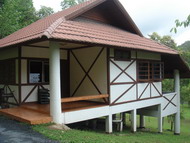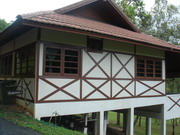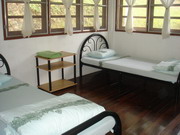|
National parks in the North
Khun Chae National Park
Topography
Khun Chae national park, located 1 hour drive to the northeast of Chiang Mai, was declared a nation park in 1995 due to its important water resources, extensive forests, wildlife, beautiful waterfalls and scenic views. Deriving its name from Khun Chae waterfalls, the park covers 270 square kilometers.
Khun Chae national park is located in the area where the exposed base rock is of two different types: igneous and sedimentary. Most of the park is covered with granite, an igneous rock common in northern Thailand. Granite looks like large grains of shining salt and black pepper. The white part that looks like salt is really quartz and feldspar. The black part that looks like pepper is mica. Another igneous rock found in the park is called tuff which was expelled from a volcano as lava, but cooled relatively quickly into a gray, fine grained rock. This volcanic tuff can be found in parts of the eastern side of the park. The sedimentary rocks; sandstone, siltstone and shale are derived from sediments deposited in water and hardened into solid rock over a long period of time. The sandstone found in Khun Chae is gray, with small grains of sand mixed in a dense, hard rock. The shale is buff colored, soft and splits easily along parallel lines.
The landscape of Khun Chae is very steep with many creeks often dropping into a number of waterfalls. The steep terrain is caused primarily by the high volume of seasonal rain, and highly erodable soil.
The vegetation of Khun Chae national park is generally related to elevation. From 300 to 800 meters, the forest is composed of bamboo, deciduous and deciduous dipterocarp-oak associations; from 800 to 1,000 meters, the forest is mixed evergreen and pine. The stream bottoms are often surrounded by lush evergreen trees, wild bananas, ferns, mosses and herbaceous vegetation. These stream bottoms often form a rich oasis of vegetation in a forest that is routinely burned by villagers that hunt wildlife and graze cattle. The ridges and mountain tops are typically covered with grasses, pine, oaks and dipterocarps. Near the eastern boundary of the park, a dry dipterocarp forest dominates the landscape.
Climate
The cold season lasts from November until July, the rainy season from July until November. During the hot dry season, February to July, the temperatures range from 22 to 33ºC. During the cold dry season, November to January, the temperature ranges from 2 to 29ºC. In the rainy season temperatures range from 19 to 29ºC.
Wildlife can be seen in several different habitats. The prime places to see wildlife are in the lush river valleys and moist forests near the higher parts of the park. Though many species of wildlife have disappeared, the following list of animals have been seen recently within its boundaries: several species of civet, wild pig, barking deer, hog badger, many species of flying arboreal and ground squirrels, bats, hare. Possible species in Khun Chae include Asiatic black bear, Slow Loris, White Handed Gibbon, Leopard Cat, Serow. Birds such as Ashy Drongo, Scarlet Minivet, Gray Headed Flycatcher, White Fronted Forktail, Brown Fish Owl, Crested Serpent Eagle, Shikra, Velvet Fronted-Nuthatch, Blue Throated Barbet, CopperSmith Barbet, Blue Winged Leafbird, Brown Cheeked Fulveta, Red Bungle Fowl still exist. Reptiles in the park include Green Tree Viper, King Cobra, Flying Lizards, Geckos, Skinks.
Tourist attractions
- Maetow waterfall: It has seven levels, the highest of which is about 40 meters. From the park headquarters, the trailhead to Maetow waterfall is approximately 30 to 40 minutes by vehicle. From the trailhead, all seven levels of the fall can be reached in approximately two hours hiking.
- Khun Chae waterfall: The 6 level fall is reached by 2 hours drive from the park's headquarters to the trail head and an hour hike from there. A picnic are is provided.
- Doi Mot: The trail to Doi Mot passes through a spectacular wet evergreen forest. A lush, dense, multiple layered forest covers a clear cool pond, surrounded by a thick growth of ground plants including epiphytic and ground orchids, ferns, mosses and other plants that love shade and a wet environment. The top of the mountain, at 1700 meters, affords spectacular views of the forests and landscape of the surrounding area. Visitors can see Chiangmai province to the west, Chiang Rai province to the east, Doi Lahnga to the south and to the north, Doi Phangome.
- Doi Lahnga: At just over 2,000 meters, majestic Doi Lahnga is Thailand's fifth highest peak. The trail to the top of Doi Lahnga enable visitors to see many spectacular views of Khun Chae national park and the surrounding area. Doi Lahnga and its many sister peaks are located on the extreme southern boundary of the park, adjacent to Jae Son national park and Mae Dahkry national park.
- The Fascinating fig tree: One of the unique features of Khun Chae national park is an enormous, structurally unique, fig tree that grows near the park's headquarters. This tree is remarkable for its size, covering an area of approximately 1,660 square meters; the number and variety of plants (epiphytes) that live on it; and the fantastic structural support that its large branches get from several supporting stems.
- Forest shrine: A small Buddhist shrine, located a short distance from the park's headquarters, features a garden with a statue of the Lord Buddha and a nature trail that follows a charming mountain stream. The outdoor temple is a peaceful spot along the Chiangmai - Chiang Rai highway for travel weary motorists as well as park visitors.
- Mae Chang Khao reservoir: It is located near station 1. Picnickers ride out to the middle of the lake on a bamboo raft and enjoy their meal in the quiet and peaceful atmosphere of a freshwater lake.
Facilities
Two bungalow style accommodations are available near the headquarters. Also provided in the same area are
visitor center, parking lot, camp ground, and rest rooms. For more information please contact the park.
How to get there
The park is located adjacent to the main high way connecting Chiang Mai and Chiang Rai. To get to the park from Chiang Mai, take high way no. 118 for 56 km northeast of Chiangmai. Between Chiang Mai and Chiang Rai there are ordinary and air conditioned buses as well as pick up cars running this route.
Contact address
Khun Chae National Park
Mae Chae Dee Mai Sub-district, Amphur Wiang Pa Pao, Chiang Rai, Thailand 57260
Phone: 053-163 364, 084-366 5213
|



